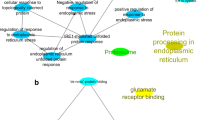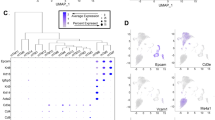Abstract
Functional development of the mammary gland is an important physiological process. Several studies have used gene expression profiling of mammary gland development to identify the key genes in the process, but few focused on the involved pathways. And there is a lack of concordance between those observed pathways. In this article, we applied a standardized microarray preprocessing to four independent studies, and then used gene set enrichment analysis (GSEA) to identify the key pathways. The result demonstrated an increased concordance between these expression profiling data sets. From the stage of puberty to pregnancy, we found 7 up-regulated and 6 down-regulated pathways in common. From the period of pregnancy to lactation, we found 7 up-regulated and 58 down-regulated pathways in common. And 10 up-regulated and 3 down-regulated pathways were found in common from lactation to the involution period. The main canonical pathways identified belong to immune system, cell communication, metabolism, and disease-related pathways. Pathway analysis is a more effective method than single gene analysis because the former one can able to detect genes weakly connected to the phenotype. As we applied GSEA to the study, our findings suggested a greater concordance in this physiological process. The critical pathways we find can provide some insight of functional development of the mammary gland and motivate other relative studies.
Similar content being viewed by others
References
Masso-Welch PA, Darcy KM, Stangle-Castor NC, Ip MM (2000) A developmental atlas of rat mammary gland histology. J Mammary Gland Biol Neoplasia 5:165–185
Richert MM, Schwertfeger KL, Ryder JW, Anderson SM (2000) An atlas of mouse mammary gland development. J Mammary Gland Biol Neoplasia 5:227–241
Rudolph MC, McManaman JL, Hunter L, Phang T, Neville MC (2003) Functional development of the mammary gland: use of expression profiling and trajectory clustering to reveal changes in gene expression during pregnancy, lactation, and involution. J Mammary Gland Biol Neoplasia 8:287–307
Clarkson RW, Wayland MT, Lee J, Freeman T, Watson CJ (2004) Gene expression profiling of mammary gland development reveals putative roles for death receptors and immune mediators in post-lactational regression. Breast Cancer Res 6:R92–R109
Subramanian A, Tamayo P, Mootha VK, Mukherjee S, Ebert BL, Gillette MA, Paulovich A, Pomeroy SL, Golub TR, Lander ES, Mesirov JP (2005) Gene set enrichment analysis: a knowledge-based approach for interpreting genome-wide expression profiles. Proc Natl Acad Sci USA 102:15545–15550
Visvader JE, Venter D, Hahm K, Santamaria M, Sum EY, O’Reilly L, White D, Williams R, Armes J, Lindeman GJ (2001) The LIM domain gene LMO4 inhibits differentiation of mammary epithelial cells in vitro and is overexpressed in breast cancer. Proc Natl Acad Sci USA 98:14452–14457
Porter DA, Krop IE, Nasser S, Sgroi D, Kaelin CM, Marks JR, Riggins G, Polyak K (2001) A SAGE (serial analysis of gene expression) view of breast tumor progression. Cancer Res 61:5697–5702
Stein T, Morris JS, Davies CR, Weber-Hall SJ, Duffy MA, Heath VJ, Bell AK, Ferrier RK, Sandilands GP, Gusterson BA (2004) Involution of the mouse mammary gland is associated with an immune cascade and an acute-phase response, involving LBP, CD14 and STAT3. Breast Cancer Res 6:R75–R91
Ron M, Israeli G, Seroussi E, Weller JI, Gregg JP, Shani M, Medrano JF (2007) Combining mouse mammary gland gene expression and comparative mapping for the identification of candidate genes for QTL of milk production traits in cattle. BMC Genomics 8:183
Anderson SM, Rudolph MC, McManaman JL, and Neville MC (2007) Key stages in mammary gland development. Secretory activation in the mammary gland: it’s not just about milk protein synthesis! Breast Cancer Res 9: 204
Mootha VK, Lindgren CM, Eriksson KF, Subramanian A, Sihag S, Lehar J, Puigserver P, Carlsson E, Ridderstrale M, Laurila E, Houstis N, Daly MJ, Patterson N, Mesirov JP, Golub TR, Tamayo P, Spiegelman B, Lander ES, Hirschhorn JN, Altshuler D, Groop LC (2003) PGC-1alpha-responsive genes involved in oxidative phosphorylation are coordinately downregulated in human diabetes. Nat Genet 34:267–273
Gentleman RC, Carey VJ, Bates DM, Bolstad B, Dettling M, Dudoit S, Ellis B, Gautier L, Ge Y, Gentry J, Hornik K, Hothorn T, Huber W, Iacus S, Irizarry R, Leisch F, Li C, Maechler M, Rossini AJ, Sawitzki G, Smith C, Smyth G, Tierney L, Yang JY, Zhang J (2004) Bioconductor: open software development for computational biology and bioinformatics. Genome Biol 5:R80
Irizarry RA, Hobbs B, Collin F, Beazer-Barclay YD, Antonellis KJ, Scherf U, Speed TP (2003) Exploration, normalization, and summaries of high density oligonucleotide array probe level data. Biostatistics 4:249–264
Gautier L, Cope L, Bolstad BM, Irizarry RA (2004) Affy-analysis of Affymetrix GeneChip data at the probe level. Bioinformatics 20:307–315
Gentleman R (2011). Using Categories to Analyze Microarray Data. http://www.bioconductor.org/packages/2.8/bioc/vignettes/Category/inst/doc/Category.pdf
Manoli T, Gretz N, Grone HJ, Kenzelmann M, Eils R, Brors B (2006) Group testing for pathway analysis improves comparability of different microarray datasets. Bioinformatics 22:2500–2506
Robinson GW, Hennighausen L, Johnson PF (2000) Side-branching in the mammary gland: the progesterone-Wnt connection. Genes Dev 14:889–894
Li M, Hu J, Heermeier K, Hennighausen L, Furth PA (1996) Expression of a viral oncoprotein during mammary gland development alters cell fate and function: induction of p53-independent apoptosis is followed by impaired milk protein production in surviving cells. Cell Growth Differ 7:3–11
Singer KL, Stevenson BR, Woo PL, Firestone GL (1994) Relationship of serine/threonine phosphorylation/dephosphorylation signaling to glucocorticoid regulation of tight junction permeability and ZO-1 distribution in nontransformed mammary epithelial cells. J Biol Chem 269:16108–16115
Buse P, Woo PL, Alexander DB, Reza A, Firestone GL (1995) Glucocorticoid-induced functional polarity of growth factor responsiveness regulates tight junction dynamics in transformed mammary epithelial tumor cells. J Biol Chem 270:28223–28227
Nguyen D-AD, Neville MC (1998) Tight junction regulation in the mammary gland. J Mammary Gland Biol Neoplasia 3:233–246
Mellenberger RW, Bauman DE (1974) Metabolic adaptations during lactogenesis fatty acid synthesis in rabbit mammary tissue during pregnancy and lactation. Biochem J 138:373–379
Barcellos-Hoff MH, Derynck R, Tsang ML, Weatherbee JA (1994) Transforming growth factor-beta activation in irradiated murine mammary gland. J Clin Invest 93:892–899
Soriano JV, Pepper MS, Orci L, Montesano R (1998) Roles of hepatocyte growth factor/scatter factor and transforming growth factor-β1 in mammary gland ductal morphogenesis. J Mammary Gland Biol Neoplasia 3:133–150
Wakefield LM, Piek E, Bottinger EP (2001) TGF-beta signaling in mammary gland development and tumorigenesis. J Mammary Gland Biol Neoplasia 6:67–82
Robinson SD, Silberstein GB, Roberts AB, Flanders KC, Daniel CW (1991) Regulated expression and growth inhibitory effects of transforming growth factor-beta isoforms in mouse mammary gland development. Development 113:867–878
Sordillo LM, Shafer-Weaver K, DeRosa D (1997) Immunobiology of the mammary gland. J Dairy Sci 80:1851–1865
Weisz-Carrington P, Roux ME, McWilliams M, Phillips-Quagliata JM, Lamm ME (1978) Hormonal induction of the secretory immune system in the mammary gland. Proc Natl Acad Sci USA 75:2928–2932
Wiseman BS, Werb Z (2002) Stromal effects on mammary gland development and breast cancer. Science 296:1046–1049
Schorr K, Li M, Krajewski S, Reed JC, Furth PA (1999) Bcl-2 gene family and related proteins in mammary gland involution and breast cancer. J Mammary Gland Biol Neoplasia 4:153–164
Cao Y, Karin M (2003) NF-κB in mammary gland development and breast cancer. J Mammary Gland Biol Neoplasia 8:215–223
Politi K, Feirt N, Kitajewski J (2004) Notch in mammary gland development and breast cancer. Semin Cancer Biol 14:341–347
Russo J, Hu YF, Silva ID, Russo IH (2001) Cancer risk related to mammary gland structure and development. Microsc Res Tech 52:204–223
Acknowledgments
This study was supported by the National Natural Science Foundation of China (Grant nos. 30871782 and 30671492).
Author information
Authors and Affiliations
Corresponding author
Additional information
Hongbo Zhao and Mini Huang contributed equally to this study.
Electronic supplementary material
Below is the link to the electronic supplementary material.
Rights and permissions
About this article
Cite this article
Zhao, H., Huang, M., Chen, Q. et al. Comparative gene expression analysis in mouse models for identifying critical pathways in mammary gland development. Breast Cancer Res Treat 132, 969–977 (2012). https://doi.org/10.1007/s10549-011-1650-8
Received:
Accepted:
Published:
Issue Date:
DOI: https://doi.org/10.1007/s10549-011-1650-8




